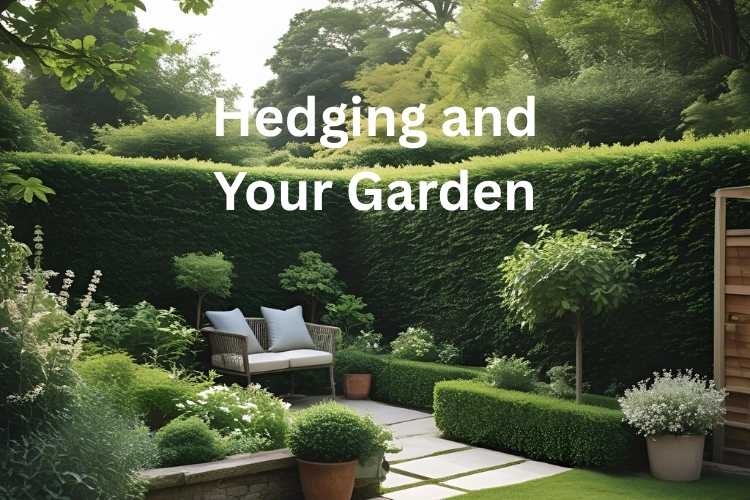Choosing Planting and Caring for Your Hedge
15th Jun 2025
There’s nothing quite like a well-kept hedge to frame a garden and give you a bit of privacy. Not to mention bring an attractive and evergreen feature to your garden. Whether you're gardening in a cosy terrace, a sprawling countryside plot, or an urban space, garden hedging plants can be both practical and a wonderful feature. From fast-growing screens to formal clipped borders, hedging plays a huge role in how we shape our gardens.
In this guide, we’ll take you through everything you need to know — from the benefits of hedging plants to choosing the right type, how to plant them, and common questions around care and maintenance.
Benefits of Garden Hedging Plants
Don’t think of your hedging as simply green fences. They’re so much more than that. They are living, breathing parts of the garden that offer a surprising number of benefits.
Privacy and security
Of course, the most obvious reason people plant hedges is for privacy. A tall, thick hedge can block out neighbours, busy roads, or unwanted views. And it looks an awful lot nicer than a wooden fence or brick wall. If you’re in a hurry laurel and Leylandii, offer fast and thick coverage, giving you a private space in no time.
Shelter and windbreaks
In open gardens, especially if you’re in the countryside or on the coast, hedges can act as natural windbreaks. They will protect your garden plants from harsh weather but it can also make warmer, more sheltered spots that are perfect for delicate plants.
Noise reduction
While they’re not entirely soundproof, it’s surprising how effective thick hedging can be in helping to reduce street noise, especially when combined with other natural features like trees or gravel paths. A mature evergreen hedge can make a real difference to the feel of a noisy garden.
Year-round Enjoyment
By their very nature hedges give gardens structure. They will define spaces, create paths, and break up borders. But the very best thing about garden hedging plants is that they remain evergreen offering colour and coverage all year round. As a bonus deciduous hedges like beech or hornbeam provide seasonal change and winter form.
Wildlife value
Hedging plants native to the UK like hawthorn are brilliant for wildlife. They offer food, nesting spots, and shelter to birds, insects, and even the odd mammal or two. Even non-native evergreen hedges can provide cover for wildlife.
Types of Hedging Plants
There’s a hedging plant to suit every type of garden — and every type of gardener. Including you.
Fast-Growing Hedges
If you’re looking to get a decent sized hedge quickly, and most of us will be, fast-growing hedges are the way to go. No surprise there. Laurel, Leylandii, and Portuguese Laurel are all popular for rapid growth. Just be aware — what grows fast will need trimming more often! If you’re in a real hurry Direct Hedging plants sell a range of mature hedging trees by the pallet load. Order today, and you’ll have a fully formed and mature hedge within the week.
Evergreen Hedges
Evergreens keep their leaves all year, giving consistent coverage and colour. Yew is a classic for formal gardens, while Photinia ‘Red Robin’ adds a splash of colour with its red-tinted new leaves. Box is also a favourite for lower but more tidy borders.
Deciduous Hedges
These lose their leaves in winter, but often retain a twiggy structure that still gives privacy. Beech and hornbeam are the stars here. They look beautiful whatever the time of year and are great for traditional planting schemes.
Native Hedges
Perfect for wildlife, native hedging plants like hawthorn, blackthorn, and hazel have seasonal flowers, berries, and wildlife love them. They’re well suited to rural, cottage-style, or wildlife-friendly gardens.
Ornamental or Flowering Hedges
Want a hedge that makes a statement? Escallonia, hydrangea, or lilac can form loose hedges with the added attraction of scent and colour. These plants suit more informal gardens but can also be used for softening hard edges along fences and walls.
How to Choose the Right Hedging Plant
Choosing a hedging plant isn’t just about what looks good — although that is really important for most of us. But here’s a few other things to consider:
What’s the hedge for?
Pretty obvious but take a moment to think about why you want a hedge. Is it for privacy? To attract wildlife? Wind protection? Or do you just want a tidy border to shape the garden? Whatever the reason it will determine your choice of hedging plant.
How much space do you have?
Some hedges can grow to 10 feet or more unless regularly trimmed. The sky is almost the limit with conifers! If you’re tight on space, look for compact or slow-growing varieties. If you’ve a creative you can even train your hedge as a feature with topiary.
Soil and light conditions
Most hedging plants are fairly adaptable and very hardy. But it can help to match your plant to the site. Clay soils? Hornbeam does well. Dry, sunny spots? Try lilac. Shaded areas? Yew or laurel may suit better. Conifers will thrive just about anywhere.
Maintenance level
Be honest with yourself — how much time do you want to spend clipping your hedge? If you’re like me you’ll want to do the minimum. Remember fast growers need frequent trims to keep them tidy If you want to keep the trimmer in the shed look for slow growers or neat natural formers like box or beech.
Appearance and style
Do you want a formal, tightly clipped hedge? Or something loose and natural? Your existing planting scheme or garden design/layout will shape your choice of hedge to a large extend. But there’s no harm in mixing it up across different areas.
Planting a Hedge: Step-by-Step
Planting a hedge is straightforward if you follow a few golden rules.
1. When to plant
• Bare root plants: Best planted between November and March while they are still dormant.
• Potted plants: Can be planted any time of year, but avoid dry spells or frozen ground.
2. Prepare the site
• It doesn’t have to be backbreaking work but so prepare the ground by removing weeds, roots, and debris.
• Dig a trench at least twice as wide as the root ball and about 30cm deep.
• Improve heavy or poor soil with compost or organic matter.
3. Space correctly
Spacing depends on the variety of plant and this is a very general guide but as a rule:
• Small hedges (e.g. box): 20–30cm apart.
• Medium hedges (e.g. laurel, beech): 30–45cm apart.
• Large hedges (e.g. leylandii): 60–100cm apart.
4. Planting
• Place plants in the trench, ensuring roots are well spread.
• Backfill with a mix of soil and compost.
• Firm in gently and water well.
5. Mulch and water
• Apply a thick mulch to retain moisture and keep those pesky weeds at bay.
• Water regularly for the first year, especially in dry spells.
6. Pruning
• Lightly trim the tops and sides to encourage bushy growth. Even if you lose a bit of height initially.
Garden Hedging Plants FAQs
What’s the best time to plant a hedge?
Late autumn to early spring (November–March) is ideal for planting bare root hedging plants. Container-grown plants can go in at any time, though planting in autumn or spring is easier and avoids the low temperatures of winter.
How far apart should I plant my hedge?
It depends on the plant and how fast you want the hedge to fill out. Fast-growing hedges like leylandii or laurel are often spaced at 60–100cm apart, while slower or smaller types are planted closer — 20–45cm.
Do hedges need feeding?
It’s not essential but feeding in spring can give your hedge a boost and encourage it to grow faster. This is especially true for fast-growing or newly planted hedges. If you want to feed your hedge, use a general-purpose fertiliser.
How often should I water my hedge?
Newly planted hedges need regular watering in their first year until they are established. This should be one or twice a week in dry weather. Once established hedges rarely need any extra watering unless there is very long and hot drought.
When should I prune my hedge?
• Fast growers (like leylandii): 2–3 times a year to keep neat.
• Formal hedges: Once or twice a year, usually in late spring and late summer.
• Native hedges: Once a year will do the job, ideally after flowering or berrying.
Can I grow a hedge in containers?
Yes — compact species like box, lavender, or dwarf you can thrive in pots. Just make sure containers are deep enough and have good drainage.
What are the best low-maintenance options?
Consider yew, beech, hornbeam, or box. These grow slowly and hold their shape well. Avoid leylandii if you want a no-fuss hedge!
Do hedges get pests or diseases?
Yes — box blight, aphids, and mildew are a few examples. Healthy plants in the right position are more resistant, and regular pruning helps with air flow.
Next Steps
Hedging plants can be more than just a boundary marker. They shape the whole look and feel of your garden, and they can also be used as single plants to march along a path or walkway. Some look great in pots and they are generally a versatile and attractive plant for any garden. You don’t have to just use hedging plants as a hedge.
Ready to start planting?
Browse our full range of garden hedging plants and find the perfect match for your space.
And don’t forget to explore our other guides for help choosing fast-growing, evergreen, low-maintenance, or native hedging to help you plan your perfect hedge.


